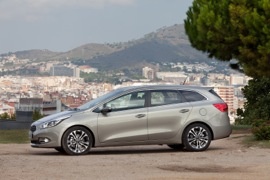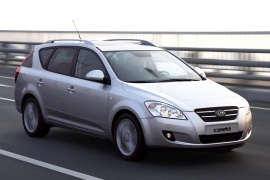KIA cee'd SW Models/Series Timeline, Specifications & Photos
First production year: 2007
Engines: Diesel, Gasoline
Body style: Wagon (station wagon, estate, combi, touring)
Kia introduced the second generation of its compact hatchback cee'd model in March 2012 at the Geneva Motor Show in Europe, and next to it was the station wagon version of it, named Sportswagon.
The Korean automaker continued its assault on the European market with the second generation of the cee'd. To make it even more appropriate for the Old Continent's customers, Kia designed it in Germany and produced it in Europe, in Slovakia. As a result, the vehicle came at a competitive price, even though it was more expensive than the model that it replaced.
Following the new design language created by Peter Schreyer, the second generation of the cee'd Sportswagon featured a new front fascia that emphasized the “tiger-nose” look of the grille. The new headlights looked fresh and addressed the younger generation with their swept-back design. On the lower part of the bumper, the automaker installed a broad grille and the fog lamps, which were available as options. Furthermore, the two creases on the hood amplified the dynamic image of the car. From its profile, the ascending beltline of the Sportswagon continued behind the rear doors since the rear overhang was longer to accommodate the enlarged trunk area. Unusually, for an affordable vehicle, the station wagon didn't share its rear doors with the hatchback. In addition, Kia installed a third set of windows between the C- and the D-pillars. Furthermore, to confirm the “sports” from the Sportswagon nameplate, the automaker made a raked-forward tailgate that elegantly ended the vehicle.
Just like its hatchback sibling, the Sportswagon featured a pair of bolstered front seats separated by a tall center console that housed an armrest, a storage compartment with a sliding cover, the gear stick, and the handbrake. One noticeable improvement over this version's previous generation was the materials' quality that surrounded the cabin. It didn't look like a cheap car anymore, even though it was still considered a budget vehicle. Since the car came in an era when most automakers started to install touchscreens for infotainment systems, Kia also added such a feat on the Sportswagon as an option. It filled the mid-section of the center stack between the vents and the HVAC control unit. Inside the instrument cluster, the automaker placed a TFT inside the center-mounted speedometer, which was flanked by the tachometer on the left and the fuel gauge and water temperature indicators on the right. In the back, the automaker installed a 60/40 split-folding bench seat that could expand the trunk space from 528 liters (18.6 cu-ft) to 1642 liters (58 cu-ft).
Compared to its predecessor, the 2012 Sportswagon sat 40 mm (1.6”) lower, thus creating an even sportier image for the vehicle. It didn't look like a small LCV but a longer hot hatch. Still, the available engines didn't recommend it for fast travel. A 99 HP (101 PS) gasoline engine powered the entry level of the vehicle and sent its ponies to the front wheels. The most potent version of the Sportswagon was a 1.6-liter turbocharged gasoline powerplant that provided 133 HP (135 PS) to the wheels via either a six-speed manual or a six-speed automatic. Since Europeans loved diesel engines, Kia offered a choice of two oil burners mated with manual or automatic gearboxes.
The Korean car manufacturer decided to build a C-segment vehicle designed specially for Europe.
The C’eed nameplate came from the European Economic Community - CEE in some places - and the ED stood for “European Design”.

Kia managed to guess the taste and the needs of the European consumers and came with a great design and a very practical vehicle.
The Sport Wagon was a variant of the small family car. The spacious car offered a inverted L-shape with its hinges set back over the cargo area - the tailgate rises almost vertically and facilitated easy access to the spacious load area.


Although a family oriented car, the C’eed looked rather compact and sporty on the inside, with the 3-spoke steering wheel and the three-dial instrument cluster. The controls were intuitively placed and could easily be used while driving.


The C’eed was equipped with electric front and rear windows and 2 electronically adjustable exterior mirrors.

The C’eed offered great room for both the front and the rear passengers.
The trunk space was also a good size, and by folding the rear seats (with a 60/40 split configuration), the luggage space could be increased.

5 engine choices were available, with power ranging between 90 and 140 hp.
The KIA’s new 1.6-liter Diesel engine was designed in Europe for the 2007 C’eed.

The C’eed was available with 3 trim levels: LX, EX and TX. The top of the range had part-leather seats and a full leather trim. A great feature, users could choose between 4 interior finishes: Basic, Rainbow, Classic and Sporty.

